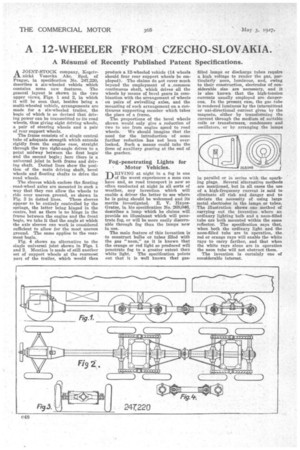A 12-WHEELER FROM CZECHO-SLOVAKIA.
Page 70

If you've noticed an error in this article please click here to report it so we can fix it.
A Résumé of Recently Published Patent Specifications.
A JOINT-STOCK company, Kopriv
nieka Vozovka Ake. Spol. of Prague, in specification No. 247,220, describes a six-wheeled vehicle which contains some new features. The general layout is shown in the two upper views, Figs. 1 and 2, in which it will be seen that, besides being a multi-wheeled vehicle arrangements are made for a six-wheeled trailer, the bogie of which is so devised that driving power can be transmitted to its road wheels, thus giving eight driving wheels, a pair of steering wheels and a pair of rear support wheels.
The frame consists of a single central tube of adequate strength which extends rigidly from the engine case, straight through the two right-angle drives to a point midway between the first bogie and the second bogie; here there is a universal joint in both frame and driving shaft. Dotted lines show the position of the main driving shaft, bevel wheels and floating shafts to drive the road wheels.
The sleeves which enclose the floating road-wheel axles are mounted in such a way that they can allow the wheels to ride over uneven ground, as shown in Pig. 3 in dotted lines. These sleeves appear to be entirely controlled by the springs, the latter being hinged in the centre, but as there is no hinge in the frame between the engine and the front bogie, we take it that the angle at which the axle sleeves can work is considered sufficient to allow for the most uneven ground. The same applies to the rearmost bogie.
Pig. 4 shows an alternative to the single universal joint shown in Figs. 1 and 2. Mention is made of still another set of support wheels at the rearmost part of the trailer, which would then produce a 12-wheeled vehicle (14 wheels should four rear support wheels be employed). The claims do not cover much beyond the employment of a common eontinuous shaft, which drives all the wheels by means of bevel gears in combination with the arrangement of wheels on pairs of swivelling axles, and the mounting of such arrangement on a continuous supporting member which takes the place of a frame.
The proportions of the bevel wheels shown would only give a reduction of two to one from engine speed to road wheels. We should imagine that the need for the introduction of some further reduction has not been overlooked. Such a means could take the form of auxiliary gearing at the end of the gearbox.
Fog-penetrating Lights for Motor Vehicles.
DRIVING at night in a fog is one of the worst experiences a man can have and, as road transport is now so often conducted at night in all sorts of weather, any invention which will enable a driver the better to see where he is going should be welcomed and its merits investigated. E. V. HayesGratze, in his specification No. 268,0443, describes a lamp which he claims will provide an illuminant which will penetrate fog, or will be more easily discernable through fog than the lamps now in use.
The main feature of this invention is to construct bulbs or tubes filled with the gas "neon," as it is known that the orange or red light so produced will penetrate fog to a greater extent than
white light. The specification points out that it is well known that gas filled lamps or discharge tubes require a high voltage to render the gas, particularly neon, luminous, and, owing to their construction, electrodes of considerable size are necessary, and it is also known that the high-tension currents uaually employed are danger. ous. In the present case, the, gas tube is rendered luminous by the intermittent or uni-directional current given by the magneto, either by transforming the current through the medium of suitable coils or •transformers, condensers and oscillators, or by arranging the lamps
in parallel or in series with the sparking plugs. Several alternative methods are mentioned, but in all cases thEi use of a high-frequency Current is said to eliminate all risk and danger and to obviate the necessity of using large metal electrodes in the lamps or tubes. The illustration shows one method of carrying out the invention where an ordinary lighting bulb and a neon-filled tube are both mounted within the same reflector. The specification says that, when both the ordinary light and the neon-filled tube are in operation, the red or orange rays will enable the white rays to carry farther, and that when the white raya alone are in operation the neon tube will not obstruct them.
The invention is certainly one of considerable interest.












































































































